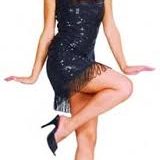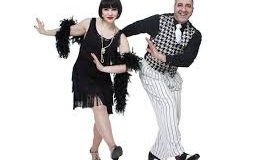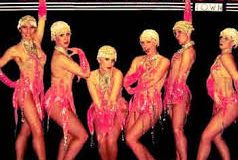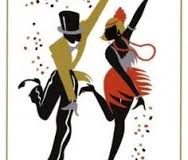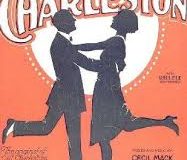1920s 1921 – May – The musical “Shuffle Along” included Charleston dancing, although it was not called the Charleston. The songs were written by Sissle and Blake and choreographed by Ned Wayburn . 1923 – “Lisa” An off-broadway musical by Irving C. Miller introduces the Charleston danced by Rufus Greenlee and Maude Russell. 1923 – October – “Runnin Wild” This ...
Read More »Charleston
Charleston Groups
In swing dance or Lindy Hop communities today, both solo 20s Charleston and solo swinging Charleston are often danced in groups arranged in a loose circle on the social dance floor, in two long lines of facing dancers (evenly spaced) or in other formations in more strictly choreographed performances. They may choose to follow steps ‘called’ either by a designated ...
Read More »Partner Charleston
Partner Charleston uses the basic step described above, though stylistic changes over the 1920s, ’30s and ’40s affected the styling, as well as ways of holding a partner. Traditionally partner Charleston was danced by a man and woman, but now both men and women may dance with same-sex partners. 20s Partner Charleston In the 20s, Partner Charleston couples stand facing ...
Read More »Solo 1920s Charleston competition
Solo 1920s Charleston competitions often utilize elements of the jam circle format, where individual competitors take turns dancing alone for the audience (usually for intervals of a phrase or number of phrases). Competitors move forwards to the audience out of an informal line, usually taking advantage of this movement to perform ‘strolls’ or other ‘traveling’ steps, taking the opportunity to ...
Read More »Solo 20s Charleston
Solo 20s Charleston has recently gained popularity in many local Lindy Hop scenes around the world, prompted by competitions such as the Ultimate Lindy Hop Showdown (in 2005 and 2006 particularly) and workshops in the dance taught by high profile dancers such as the Harlem Hot Shots (formerly known as The Rhythm Hot Shots) and a range of independent dancers. ...
Read More »Contemporary Charleston
Today Charleston is an important dance in Lindy Hop dance culture, danced in many permutations: solo, with a partner, or in groups of couples or solo dancers. The basic step allows for a vast range of variations and improvisation. Both the 1920s and Swinging Charleston styles are popular today, though swinging Charleston is more commonly integrated into Lindy Hop dancing. ...
Read More »Tap Charleston
Tap Charleston: Leonard Reed was said to have invented Tap Charleston after he learned tap in 1925. Tap Charleston was the Charleston with breaks into open position to do tap steps. The connection between Breakaway and Tap Charleston is murky therefore it could be the same thing attributed to Leonard Reed or something else.
Read More »Charleston rhythm
The characteristic Charleston beat, which Johnson said he first heard from Charleston dockworkers, incorporates the clave rhythm and was considered by composer and critic Gunther Schuller to be synonymous with the Habanera, and the Spanish Tinge. Johnson actually recorded several “Charlestons,” and in later years derided most of them as being of “that same damn beat.” Several of these were ...
Read More »Origins of the Charleston
While cutting shapes as a dance probably came from the “star” or challenge dances that were all part of the African-American dance called Juba, the particular sequence of steps which appeared in Runnin’ Wild were probably newly devised for popular appeal.”At first, the step started off with a simple twisting of the feet, to rhythm in a lazy sort of ...
Read More »Charleston
The Charleston is a dance named for the harbor city of Charleston, South Carolina. The rhythm was popularized in mainstream dance music in the United States by a 1923 tune called “The Charleston” by composer/pianist James P. Johnson which originated in the Broadway show Runnin’ Wild and became one of the most popular hits of the decade. Runnin’ Wild ran ...
Read More »